Annotated Bibliography: Workplace Communication Skills, MGT502
VerifiedAdded on 2022/07/28
|9
|2210
|39
Annotated Bibliography
AI Summary
This annotated bibliography explores key aspects of workplace communication, drawing from various academic sources. It examines verbal communication behaviors, barriers to effective communication, and the impact of social media and email policies. The bibliography includes analyses of articles discussing communication skills, the role of communication in organizational success, and the preferences of millennial employees. The sources address topics such as communication competencies, the alignment of workplace needs with business school curricula, and the perceptions of employees regarding workplace communication. The bibliography highlights the importance of clear, concise communication, and the need for managers to foster open communication environments. The included studies utilize different research methodologies, from content analysis to qualitative interviews, providing a comprehensive overview of the subject.
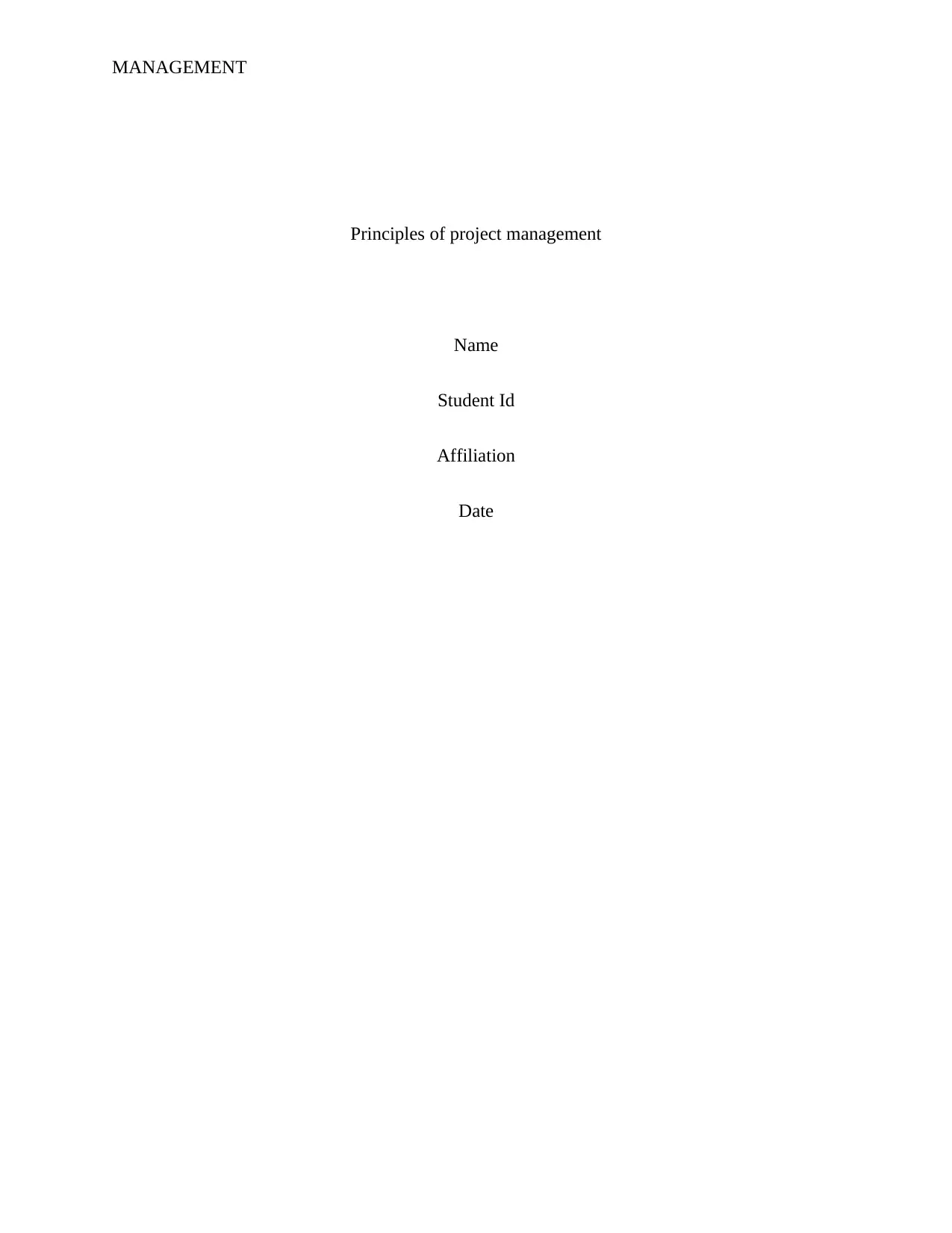
MANAGEMENT
Principles of project management
Name
Student Id
Affiliation
Date
Principles of project management
Name
Student Id
Affiliation
Date
Paraphrase This Document
Need a fresh take? Get an instant paraphrase of this document with our AI Paraphraser
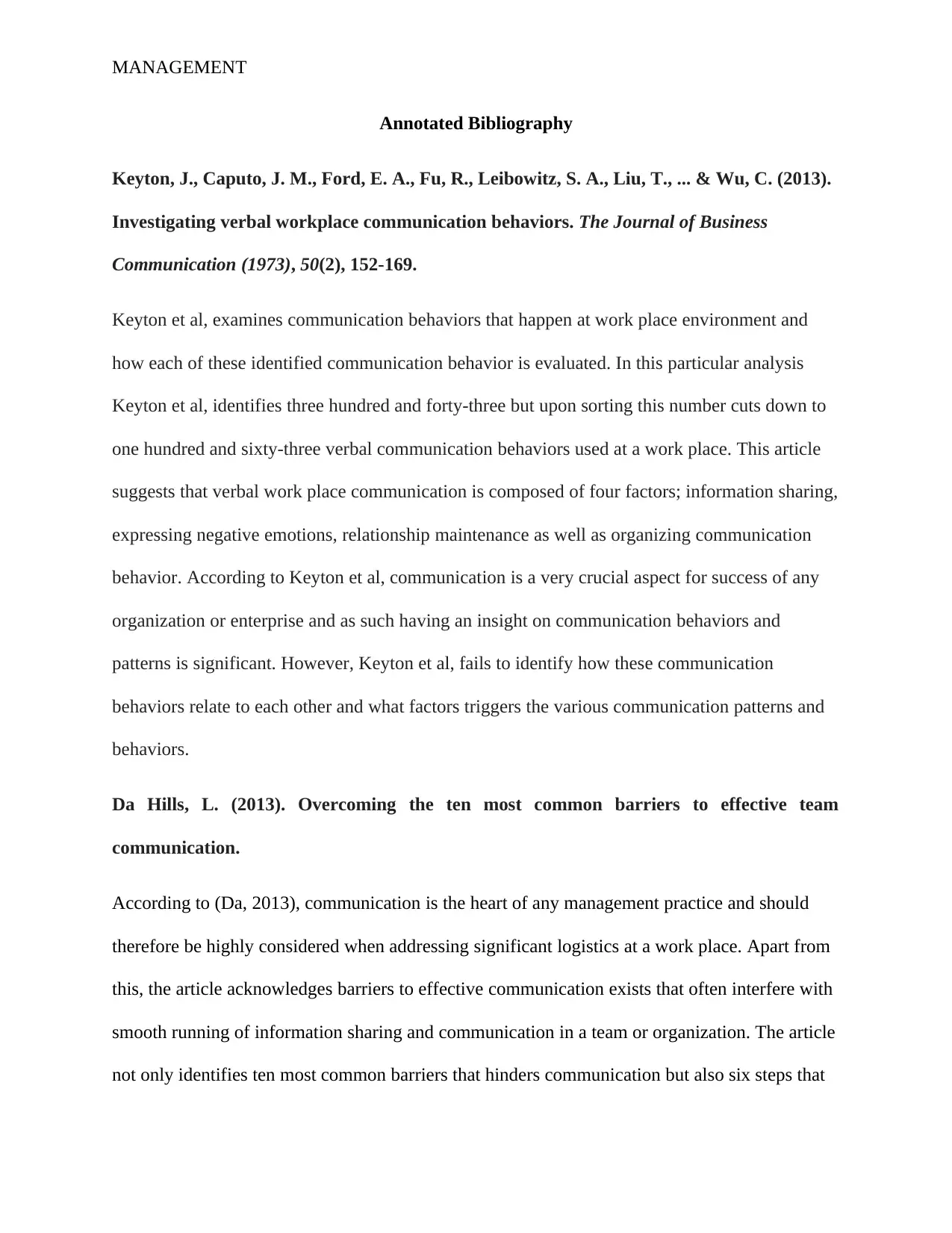
MANAGEMENT
Annotated Bibliography
Keyton, J., Caputo, J. M., Ford, E. A., Fu, R., Leibowitz, S. A., Liu, T., ... & Wu, C. (2013).
Investigating verbal workplace communication behaviors. The Journal of Business
Communication (1973), 50(2), 152-169.
Keyton et al, examines communication behaviors that happen at work place environment and
how each of these identified communication behavior is evaluated. In this particular analysis
Keyton et al, identifies three hundred and forty-three but upon sorting this number cuts down to
one hundred and sixty-three verbal communication behaviors used at a work place. This article
suggests that verbal work place communication is composed of four factors; information sharing,
expressing negative emotions, relationship maintenance as well as organizing communication
behavior. According to Keyton et al, communication is a very crucial aspect for success of any
organization or enterprise and as such having an insight on communication behaviors and
patterns is significant. However, Keyton et al, fails to identify how these communication
behaviors relate to each other and what factors triggers the various communication patterns and
behaviors.
Da Hills, L. (2013). Overcoming the ten most common barriers to effective team
communication.
According to (Da, 2013), communication is the heart of any management practice and should
therefore be highly considered when addressing significant logistics at a work place. Apart from
this, the article acknowledges barriers to effective communication exists that often interfere with
smooth running of information sharing and communication in a team or organization. The article
not only identifies ten most common barriers that hinders communication but also six steps that
Annotated Bibliography
Keyton, J., Caputo, J. M., Ford, E. A., Fu, R., Leibowitz, S. A., Liu, T., ... & Wu, C. (2013).
Investigating verbal workplace communication behaviors. The Journal of Business
Communication (1973), 50(2), 152-169.
Keyton et al, examines communication behaviors that happen at work place environment and
how each of these identified communication behavior is evaluated. In this particular analysis
Keyton et al, identifies three hundred and forty-three but upon sorting this number cuts down to
one hundred and sixty-three verbal communication behaviors used at a work place. This article
suggests that verbal work place communication is composed of four factors; information sharing,
expressing negative emotions, relationship maintenance as well as organizing communication
behavior. According to Keyton et al, communication is a very crucial aspect for success of any
organization or enterprise and as such having an insight on communication behaviors and
patterns is significant. However, Keyton et al, fails to identify how these communication
behaviors relate to each other and what factors triggers the various communication patterns and
behaviors.
Da Hills, L. (2013). Overcoming the ten most common barriers to effective team
communication.
According to (Da, 2013), communication is the heart of any management practice and should
therefore be highly considered when addressing significant logistics at a work place. Apart from
this, the article acknowledges barriers to effective communication exists that often interfere with
smooth running of information sharing and communication in a team or organization. The article
not only identifies ten most common barriers that hinders communication but also six steps that
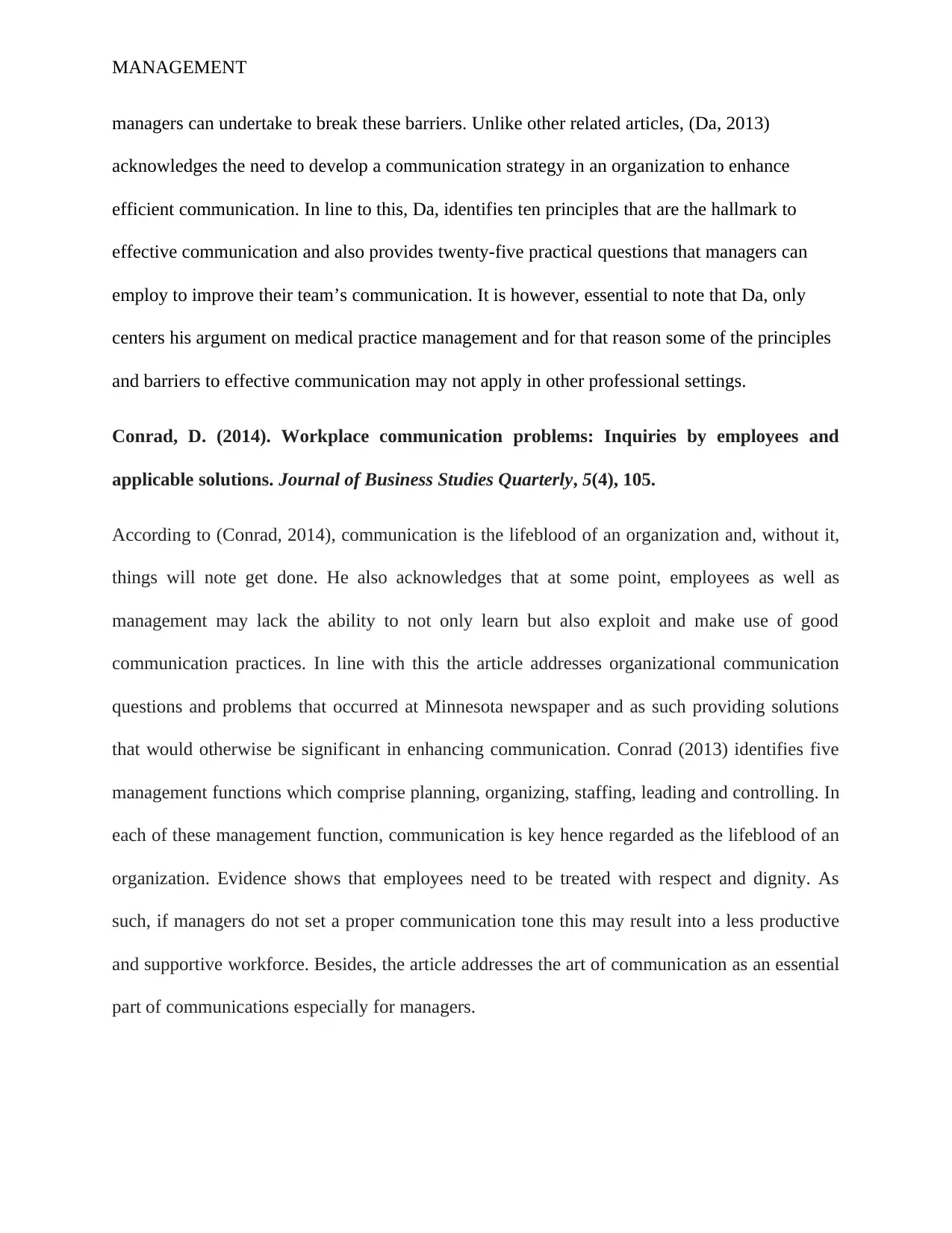
MANAGEMENT
managers can undertake to break these barriers. Unlike other related articles, (Da, 2013)
acknowledges the need to develop a communication strategy in an organization to enhance
efficient communication. In line to this, Da, identifies ten principles that are the hallmark to
effective communication and also provides twenty-five practical questions that managers can
employ to improve their team’s communication. It is however, essential to note that Da, only
centers his argument on medical practice management and for that reason some of the principles
and barriers to effective communication may not apply in other professional settings.
Conrad, D. (2014). Workplace communication problems: Inquiries by employees and
applicable solutions. Journal of Business Studies Quarterly, 5(4), 105.
According to (Conrad, 2014), communication is the lifeblood of an organization and, without it,
things will note get done. He also acknowledges that at some point, employees as well as
management may lack the ability to not only learn but also exploit and make use of good
communication practices. In line with this the article addresses organizational communication
questions and problems that occurred at Minnesota newspaper and as such providing solutions
that would otherwise be significant in enhancing communication. Conrad (2013) identifies five
management functions which comprise planning, organizing, staffing, leading and controlling. In
each of these management function, communication is key hence regarded as the lifeblood of an
organization. Evidence shows that employees need to be treated with respect and dignity. As
such, if managers do not set a proper communication tone this may result into a less productive
and supportive workforce. Besides, the article addresses the art of communication as an essential
part of communications especially for managers.
managers can undertake to break these barriers. Unlike other related articles, (Da, 2013)
acknowledges the need to develop a communication strategy in an organization to enhance
efficient communication. In line to this, Da, identifies ten principles that are the hallmark to
effective communication and also provides twenty-five practical questions that managers can
employ to improve their team’s communication. It is however, essential to note that Da, only
centers his argument on medical practice management and for that reason some of the principles
and barriers to effective communication may not apply in other professional settings.
Conrad, D. (2014). Workplace communication problems: Inquiries by employees and
applicable solutions. Journal of Business Studies Quarterly, 5(4), 105.
According to (Conrad, 2014), communication is the lifeblood of an organization and, without it,
things will note get done. He also acknowledges that at some point, employees as well as
management may lack the ability to not only learn but also exploit and make use of good
communication practices. In line with this the article addresses organizational communication
questions and problems that occurred at Minnesota newspaper and as such providing solutions
that would otherwise be significant in enhancing communication. Conrad (2013) identifies five
management functions which comprise planning, organizing, staffing, leading and controlling. In
each of these management function, communication is key hence regarded as the lifeblood of an
organization. Evidence shows that employees need to be treated with respect and dignity. As
such, if managers do not set a proper communication tone this may result into a less productive
and supportive workforce. Besides, the article addresses the art of communication as an essential
part of communications especially for managers.
⊘ This is a preview!⊘
Do you want full access?
Subscribe today to unlock all pages.

Trusted by 1+ million students worldwide
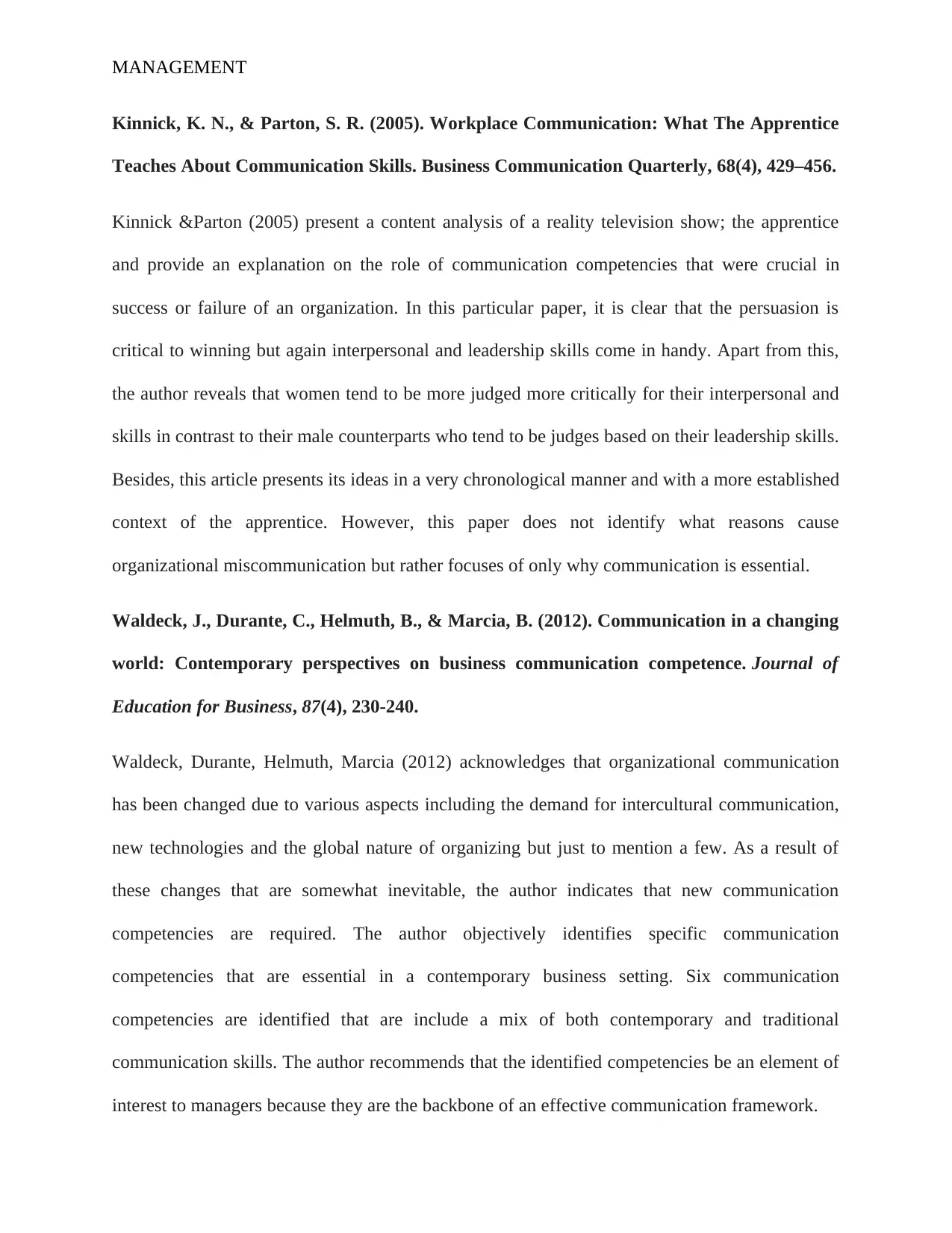
MANAGEMENT
Kinnick, K. N., & Parton, S. R. (2005). Workplace Communication: What The Apprentice
Teaches About Communication Skills. Business Communication Quarterly, 68(4), 429–456.
Kinnick &Parton (2005) present a content analysis of a reality television show; the apprentice
and provide an explanation on the role of communication competencies that were crucial in
success or failure of an organization. In this particular paper, it is clear that the persuasion is
critical to winning but again interpersonal and leadership skills come in handy. Apart from this,
the author reveals that women tend to be more judged more critically for their interpersonal and
skills in contrast to their male counterparts who tend to be judges based on their leadership skills.
Besides, this article presents its ideas in a very chronological manner and with a more established
context of the apprentice. However, this paper does not identify what reasons cause
organizational miscommunication but rather focuses of only why communication is essential.
Waldeck, J., Durante, C., Helmuth, B., & Marcia, B. (2012). Communication in a changing
world: Contemporary perspectives on business communication competence. Journal of
Education for Business, 87(4), 230-240.
Waldeck, Durante, Helmuth, Marcia (2012) acknowledges that organizational communication
has been changed due to various aspects including the demand for intercultural communication,
new technologies and the global nature of organizing but just to mention a few. As a result of
these changes that are somewhat inevitable, the author indicates that new communication
competencies are required. The author objectively identifies specific communication
competencies that are essential in a contemporary business setting. Six communication
competencies are identified that are include a mix of both contemporary and traditional
communication skills. The author recommends that the identified competencies be an element of
interest to managers because they are the backbone of an effective communication framework.
Kinnick, K. N., & Parton, S. R. (2005). Workplace Communication: What The Apprentice
Teaches About Communication Skills. Business Communication Quarterly, 68(4), 429–456.
Kinnick &Parton (2005) present a content analysis of a reality television show; the apprentice
and provide an explanation on the role of communication competencies that were crucial in
success or failure of an organization. In this particular paper, it is clear that the persuasion is
critical to winning but again interpersonal and leadership skills come in handy. Apart from this,
the author reveals that women tend to be more judged more critically for their interpersonal and
skills in contrast to their male counterparts who tend to be judges based on their leadership skills.
Besides, this article presents its ideas in a very chronological manner and with a more established
context of the apprentice. However, this paper does not identify what reasons cause
organizational miscommunication but rather focuses of only why communication is essential.
Waldeck, J., Durante, C., Helmuth, B., & Marcia, B. (2012). Communication in a changing
world: Contemporary perspectives on business communication competence. Journal of
Education for Business, 87(4), 230-240.
Waldeck, Durante, Helmuth, Marcia (2012) acknowledges that organizational communication
has been changed due to various aspects including the demand for intercultural communication,
new technologies and the global nature of organizing but just to mention a few. As a result of
these changes that are somewhat inevitable, the author indicates that new communication
competencies are required. The author objectively identifies specific communication
competencies that are essential in a contemporary business setting. Six communication
competencies are identified that are include a mix of both contemporary and traditional
communication skills. The author recommends that the identified competencies be an element of
interest to managers because they are the backbone of an effective communication framework.
Paraphrase This Document
Need a fresh take? Get an instant paraphrase of this document with our AI Paraphraser
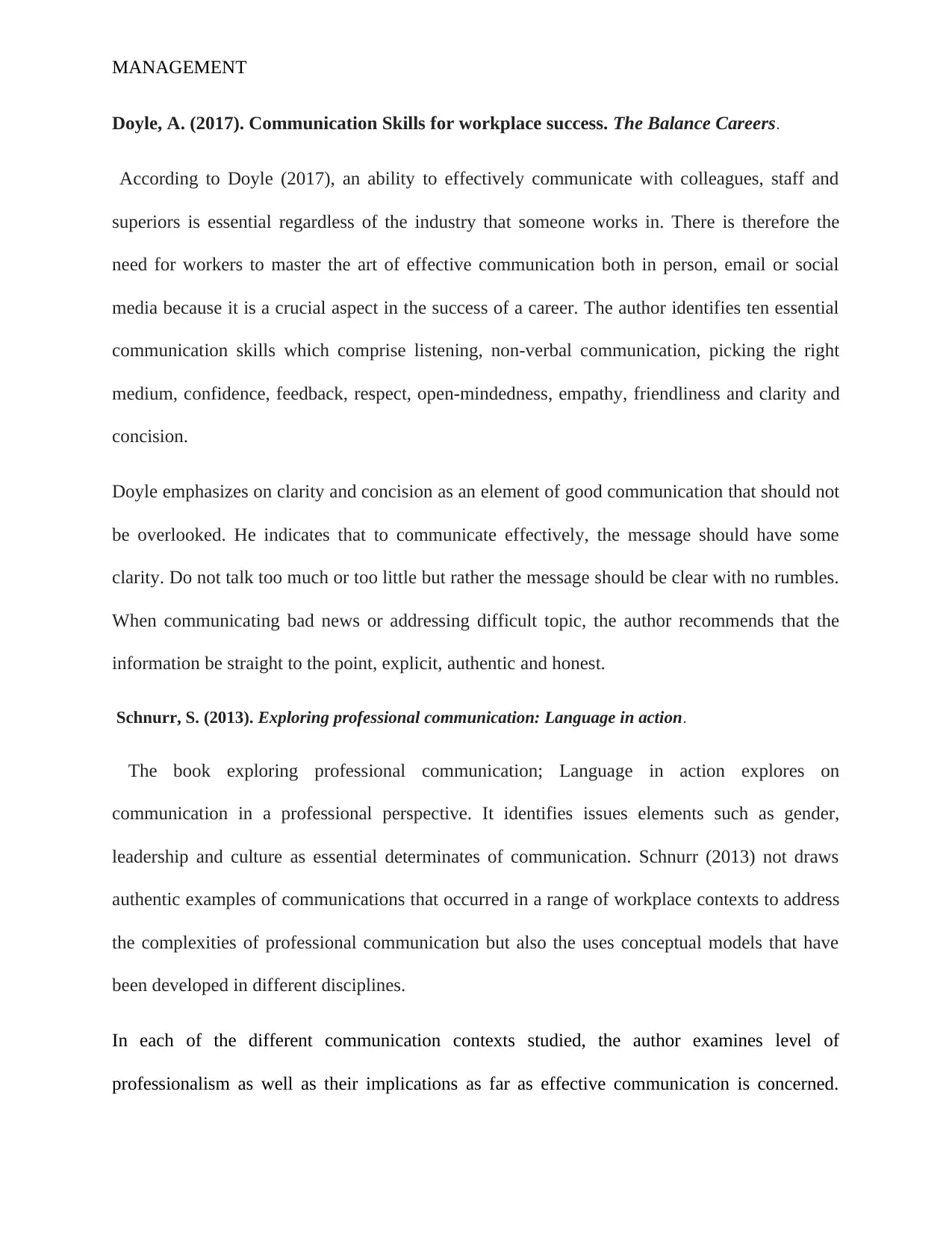
MANAGEMENT
Doyle, A. (2017). Communication Skills for workplace success. The Balance Careers.
According to Doyle (2017), an ability to effectively communicate with colleagues, staff and
superiors is essential regardless of the industry that someone works in. There is therefore the
need for workers to master the art of effective communication both in person, email or social
media because it is a crucial aspect in the success of a career. The author identifies ten essential
communication skills which comprise listening, non-verbal communication, picking the right
medium, confidence, feedback, respect, open-mindedness, empathy, friendliness and clarity and
concision.
Doyle emphasizes on clarity and concision as an element of good communication that should not
be overlooked. He indicates that to communicate effectively, the message should have some
clarity. Do not talk too much or too little but rather the message should be clear with no rumbles.
When communicating bad news or addressing difficult topic, the author recommends that the
information be straight to the point, explicit, authentic and honest.
Schnurr, S. (2013). Exploring professional communication: Language in action.
The book exploring professional communication; Language in action explores on
communication in a professional perspective. It identifies issues elements such as gender,
leadership and culture as essential determinates of communication. Schnurr (2013) not draws
authentic examples of communications that occurred in a range of workplace contexts to address
the complexities of professional communication but also the uses conceptual models that have
been developed in different disciplines.
In each of the different communication contexts studied, the author examines level of
professionalism as well as their implications as far as effective communication is concerned.
Doyle, A. (2017). Communication Skills for workplace success. The Balance Careers.
According to Doyle (2017), an ability to effectively communicate with colleagues, staff and
superiors is essential regardless of the industry that someone works in. There is therefore the
need for workers to master the art of effective communication both in person, email or social
media because it is a crucial aspect in the success of a career. The author identifies ten essential
communication skills which comprise listening, non-verbal communication, picking the right
medium, confidence, feedback, respect, open-mindedness, empathy, friendliness and clarity and
concision.
Doyle emphasizes on clarity and concision as an element of good communication that should not
be overlooked. He indicates that to communicate effectively, the message should have some
clarity. Do not talk too much or too little but rather the message should be clear with no rumbles.
When communicating bad news or addressing difficult topic, the author recommends that the
information be straight to the point, explicit, authentic and honest.
Schnurr, S. (2013). Exploring professional communication: Language in action.
The book exploring professional communication; Language in action explores on
communication in a professional perspective. It identifies issues elements such as gender,
leadership and culture as essential determinates of communication. Schnurr (2013) not draws
authentic examples of communications that occurred in a range of workplace contexts to address
the complexities of professional communication but also the uses conceptual models that have
been developed in different disciplines.
In each of the different communication contexts studied, the author examines level of
professionalism as well as their implications as far as effective communication is concerned.
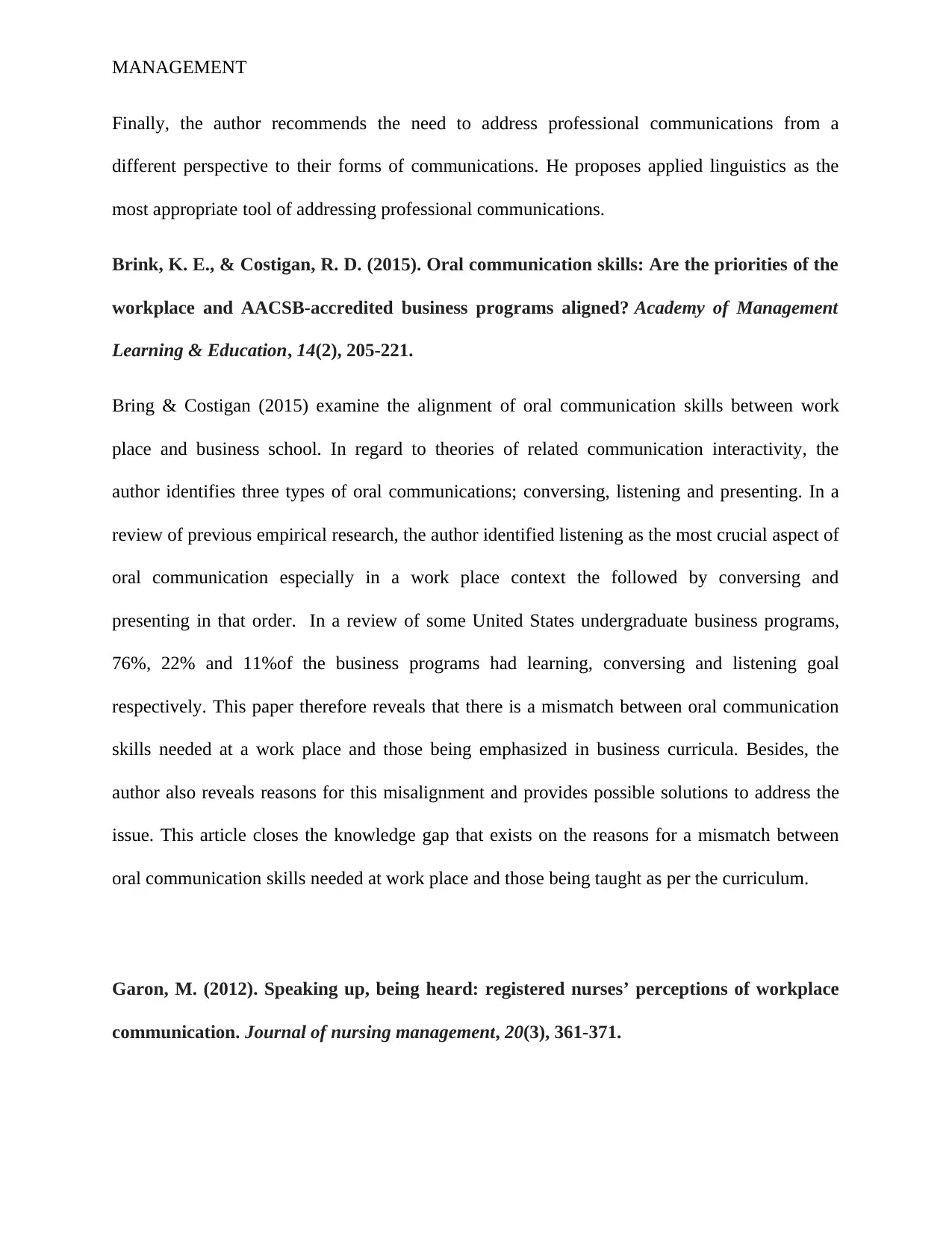
MANAGEMENT
Finally, the author recommends the need to address professional communications from a
different perspective to their forms of communications. He proposes applied linguistics as the
most appropriate tool of addressing professional communications.
Brink, K. E., & Costigan, R. D. (2015). Oral communication skills: Are the priorities of the
workplace and AACSB-accredited business programs aligned? Academy of Management
Learning & Education, 14(2), 205-221.
Bring & Costigan (2015) examine the alignment of oral communication skills between work
place and business school. In regard to theories of related communication interactivity, the
author identifies three types of oral communications; conversing, listening and presenting. In a
review of previous empirical research, the author identified listening as the most crucial aspect of
oral communication especially in a work place context the followed by conversing and
presenting in that order. In a review of some United States undergraduate business programs,
76%, 22% and 11%of the business programs had learning, conversing and listening goal
respectively. This paper therefore reveals that there is a mismatch between oral communication
skills needed at a work place and those being emphasized in business curricula. Besides, the
author also reveals reasons for this misalignment and provides possible solutions to address the
issue. This article closes the knowledge gap that exists on the reasons for a mismatch between
oral communication skills needed at work place and those being taught as per the curriculum.
Garon, M. (2012). Speaking up, being heard: registered nurses’ perceptions of workplace
communication. Journal of nursing management, 20(3), 361-371.
Finally, the author recommends the need to address professional communications from a
different perspective to their forms of communications. He proposes applied linguistics as the
most appropriate tool of addressing professional communications.
Brink, K. E., & Costigan, R. D. (2015). Oral communication skills: Are the priorities of the
workplace and AACSB-accredited business programs aligned? Academy of Management
Learning & Education, 14(2), 205-221.
Bring & Costigan (2015) examine the alignment of oral communication skills between work
place and business school. In regard to theories of related communication interactivity, the
author identifies three types of oral communications; conversing, listening and presenting. In a
review of previous empirical research, the author identified listening as the most crucial aspect of
oral communication especially in a work place context the followed by conversing and
presenting in that order. In a review of some United States undergraduate business programs,
76%, 22% and 11%of the business programs had learning, conversing and listening goal
respectively. This paper therefore reveals that there is a mismatch between oral communication
skills needed at a work place and those being emphasized in business curricula. Besides, the
author also reveals reasons for this misalignment and provides possible solutions to address the
issue. This article closes the knowledge gap that exists on the reasons for a mismatch between
oral communication skills needed at work place and those being taught as per the curriculum.
Garon, M. (2012). Speaking up, being heard: registered nurses’ perceptions of workplace
communication. Journal of nursing management, 20(3), 361-371.
⊘ This is a preview!⊘
Do you want full access?
Subscribe today to unlock all pages.

Trusted by 1+ million students worldwide
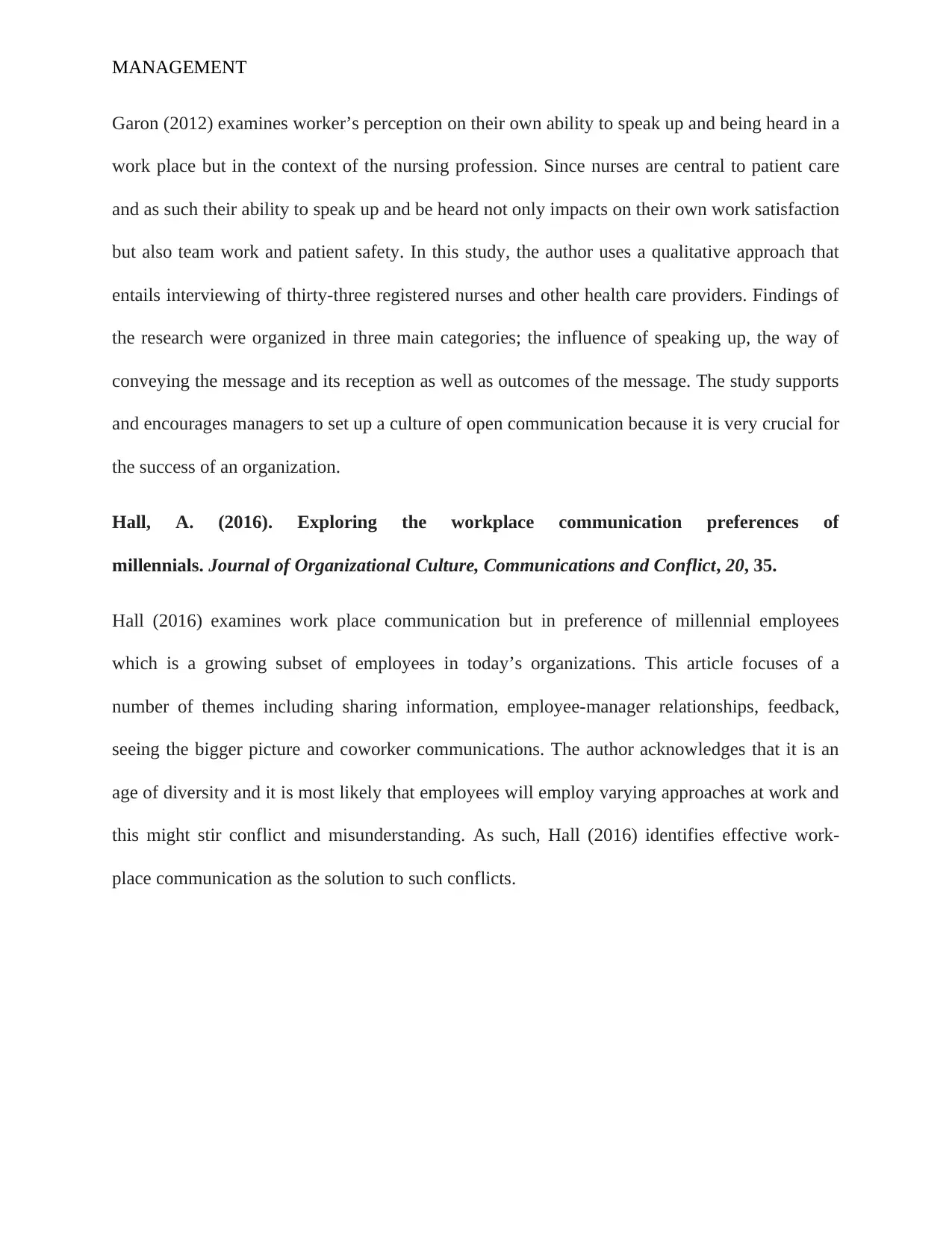
MANAGEMENT
Garon (2012) examines worker’s perception on their own ability to speak up and being heard in a
work place but in the context of the nursing profession. Since nurses are central to patient care
and as such their ability to speak up and be heard not only impacts on their own work satisfaction
but also team work and patient safety. In this study, the author uses a qualitative approach that
entails interviewing of thirty-three registered nurses and other health care providers. Findings of
the research were organized in three main categories; the influence of speaking up, the way of
conveying the message and its reception as well as outcomes of the message. The study supports
and encourages managers to set up a culture of open communication because it is very crucial for
the success of an organization.
Hall, A. (2016). Exploring the workplace communication preferences of
millennials. Journal of Organizational Culture, Communications and Conflict, 20, 35.
Hall (2016) examines work place communication but in preference of millennial employees
which is a growing subset of employees in today’s organizations. This article focuses of a
number of themes including sharing information, employee-manager relationships, feedback,
seeing the bigger picture and coworker communications. The author acknowledges that it is an
age of diversity and it is most likely that employees will employ varying approaches at work and
this might stir conflict and misunderstanding. As such, Hall (2016) identifies effective work-
place communication as the solution to such conflicts.
Garon (2012) examines worker’s perception on their own ability to speak up and being heard in a
work place but in the context of the nursing profession. Since nurses are central to patient care
and as such their ability to speak up and be heard not only impacts on their own work satisfaction
but also team work and patient safety. In this study, the author uses a qualitative approach that
entails interviewing of thirty-three registered nurses and other health care providers. Findings of
the research were organized in three main categories; the influence of speaking up, the way of
conveying the message and its reception as well as outcomes of the message. The study supports
and encourages managers to set up a culture of open communication because it is very crucial for
the success of an organization.
Hall, A. (2016). Exploring the workplace communication preferences of
millennials. Journal of Organizational Culture, Communications and Conflict, 20, 35.
Hall (2016) examines work place communication but in preference of millennial employees
which is a growing subset of employees in today’s organizations. This article focuses of a
number of themes including sharing information, employee-manager relationships, feedback,
seeing the bigger picture and coworker communications. The author acknowledges that it is an
age of diversity and it is most likely that employees will employ varying approaches at work and
this might stir conflict and misunderstanding. As such, Hall (2016) identifies effective work-
place communication as the solution to such conflicts.
Paraphrase This Document
Need a fresh take? Get an instant paraphrase of this document with our AI Paraphraser
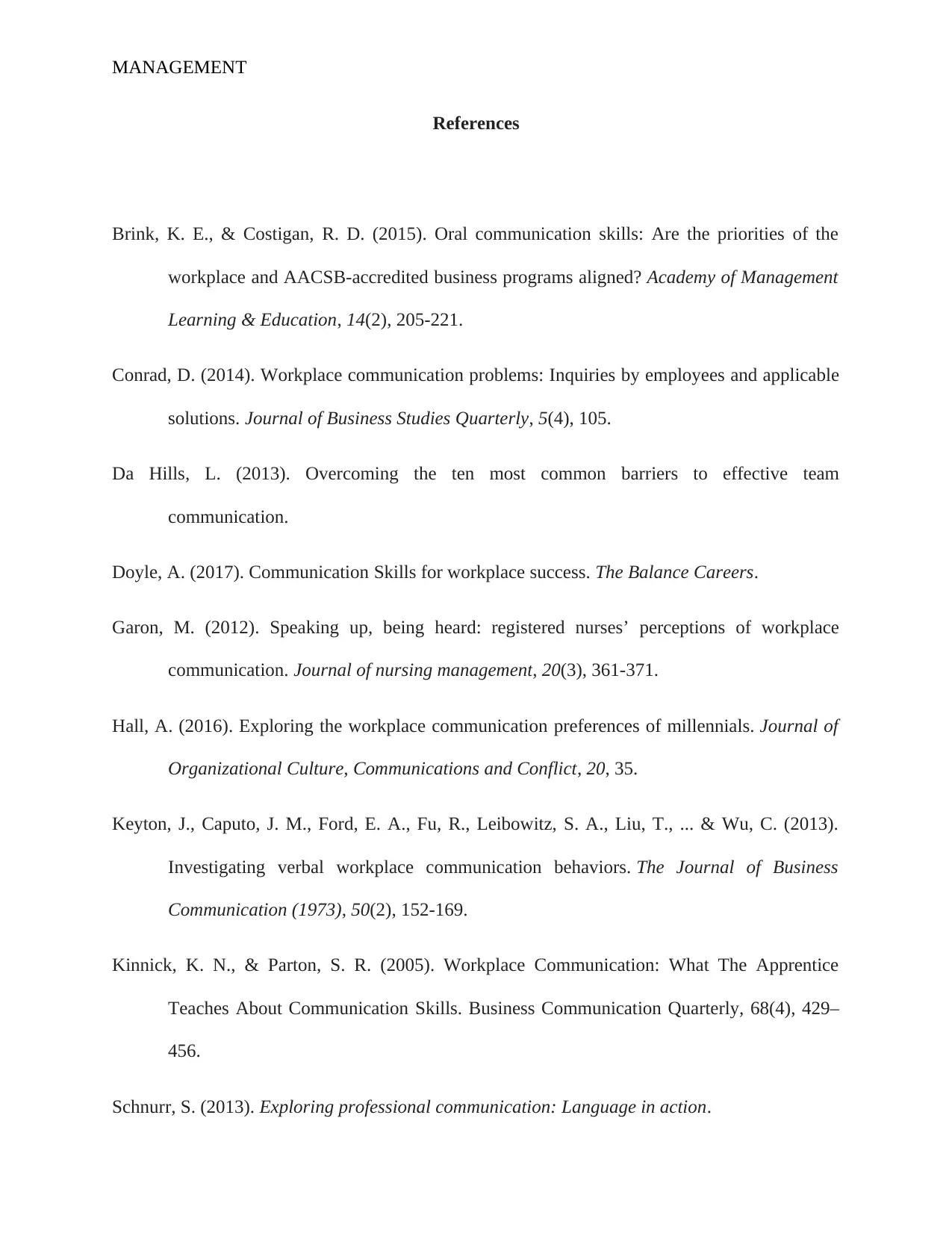
MANAGEMENT
References
Brink, K. E., & Costigan, R. D. (2015). Oral communication skills: Are the priorities of the
workplace and AACSB-accredited business programs aligned? Academy of Management
Learning & Education, 14(2), 205-221.
Conrad, D. (2014). Workplace communication problems: Inquiries by employees and applicable
solutions. Journal of Business Studies Quarterly, 5(4), 105.
Da Hills, L. (2013). Overcoming the ten most common barriers to effective team
communication.
Doyle, A. (2017). Communication Skills for workplace success. The Balance Careers.
Garon, M. (2012). Speaking up, being heard: registered nurses’ perceptions of workplace
communication. Journal of nursing management, 20(3), 361-371.
Hall, A. (2016). Exploring the workplace communication preferences of millennials. Journal of
Organizational Culture, Communications and Conflict, 20, 35.
Keyton, J., Caputo, J. M., Ford, E. A., Fu, R., Leibowitz, S. A., Liu, T., ... & Wu, C. (2013).
Investigating verbal workplace communication behaviors. The Journal of Business
Communication (1973), 50(2), 152-169.
Kinnick, K. N., & Parton, S. R. (2005). Workplace Communication: What The Apprentice
Teaches About Communication Skills. Business Communication Quarterly, 68(4), 429–
456.
Schnurr, S. (2013). Exploring professional communication: Language in action.
References
Brink, K. E., & Costigan, R. D. (2015). Oral communication skills: Are the priorities of the
workplace and AACSB-accredited business programs aligned? Academy of Management
Learning & Education, 14(2), 205-221.
Conrad, D. (2014). Workplace communication problems: Inquiries by employees and applicable
solutions. Journal of Business Studies Quarterly, 5(4), 105.
Da Hills, L. (2013). Overcoming the ten most common barriers to effective team
communication.
Doyle, A. (2017). Communication Skills for workplace success. The Balance Careers.
Garon, M. (2012). Speaking up, being heard: registered nurses’ perceptions of workplace
communication. Journal of nursing management, 20(3), 361-371.
Hall, A. (2016). Exploring the workplace communication preferences of millennials. Journal of
Organizational Culture, Communications and Conflict, 20, 35.
Keyton, J., Caputo, J. M., Ford, E. A., Fu, R., Leibowitz, S. A., Liu, T., ... & Wu, C. (2013).
Investigating verbal workplace communication behaviors. The Journal of Business
Communication (1973), 50(2), 152-169.
Kinnick, K. N., & Parton, S. R. (2005). Workplace Communication: What The Apprentice
Teaches About Communication Skills. Business Communication Quarterly, 68(4), 429–
456.
Schnurr, S. (2013). Exploring professional communication: Language in action.
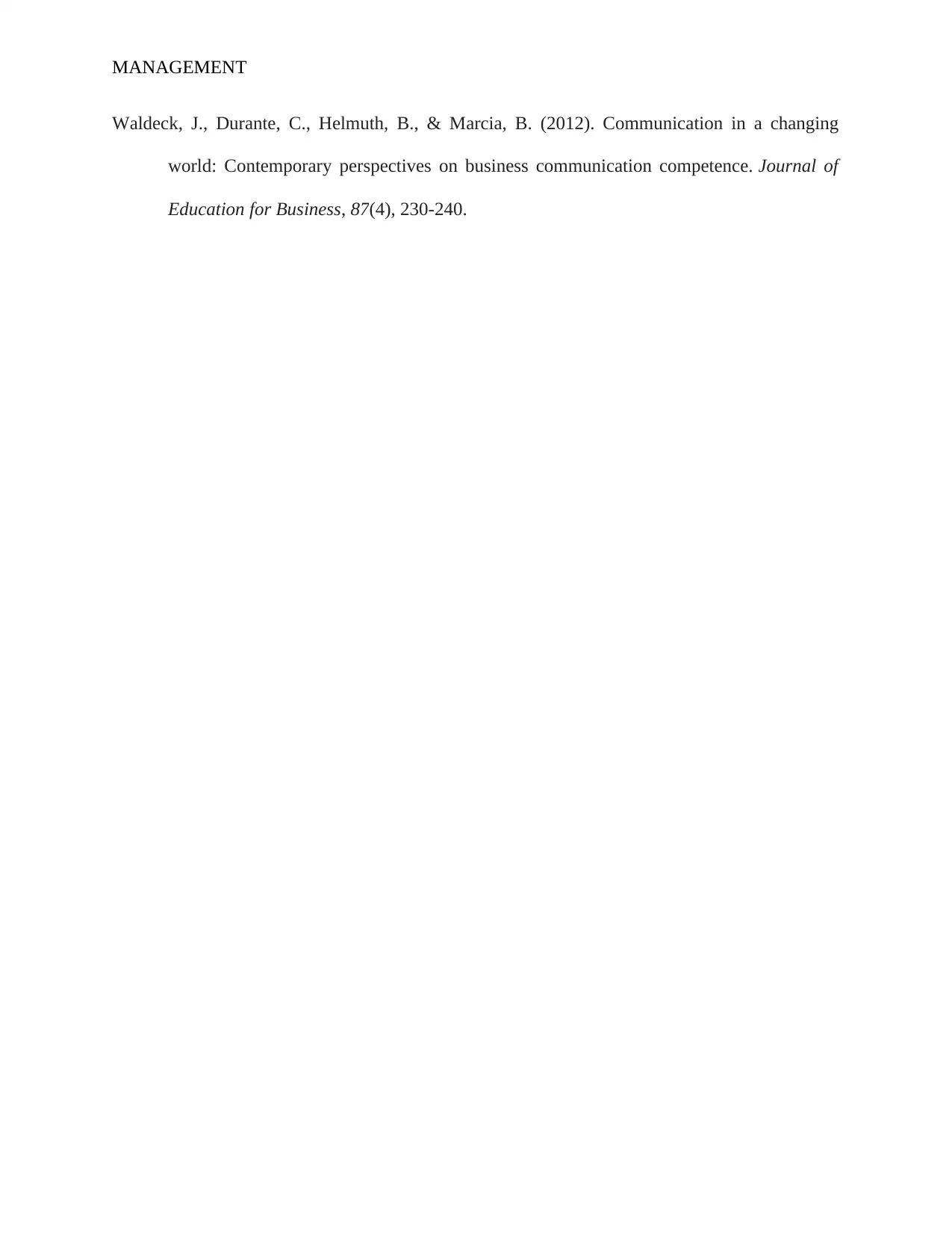
MANAGEMENT
Waldeck, J., Durante, C., Helmuth, B., & Marcia, B. (2012). Communication in a changing
world: Contemporary perspectives on business communication competence. Journal of
Education for Business, 87(4), 230-240.
Waldeck, J., Durante, C., Helmuth, B., & Marcia, B. (2012). Communication in a changing
world: Contemporary perspectives on business communication competence. Journal of
Education for Business, 87(4), 230-240.
⊘ This is a preview!⊘
Do you want full access?
Subscribe today to unlock all pages.

Trusted by 1+ million students worldwide
1 out of 9
Your All-in-One AI-Powered Toolkit for Academic Success.
+13062052269
info@desklib.com
Available 24*7 on WhatsApp / Email
![[object Object]](/_next/static/media/star-bottom.7253800d.svg)
Unlock your academic potential
Copyright © 2020–2025 A2Z Services. All Rights Reserved. Developed and managed by ZUCOL.


